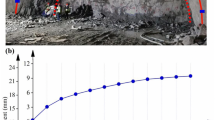Abstract
The Longtan tunnel is one key tunnel along the Hurong (Shanghai–Chengdu) national roadway in the Hubei province of China. This tunnel is a typical long and deep tunnel, with a length of approximately 8700 m and a depth of approximately 500 m. Because of the complicated geological conditions and high initial stress, to compute the stability of the surrounding rock, it is very important to back analyze the material parameters and initial stress from the measured displacements. Based on a novel evolutionary neural network proposed by the author, a new back analysis method is proposed that can be used to simultaneously determine the material parameters and the initial stress. Using this new back analysis method, some typical monitoring sections of the Longtan tunnel are computed. From numerical computations using the back analysis results, it is found that the stability of the tunnel is consistent with engineering practice and that the initial stresses determined from the back analysis coincide very well with the measured values. Therefore, using the proposed back analysis method, the relevant parameters for the entire tunnel can be conveniently obtained.



















Similar content being viewed by others
References
Dimitrios K (2005) Tunelling and tunnel mechanics. Springer, Berlin Heidelberg
Hisatake M (1994) Back analysis in tunneling. In: Vargas EA, Azevedo DF, Sousal LMR (eds) Applications of computational mechanics in geotechnical engineering. Balkema, Rotterdam, pp 3–14
Oreste P (2005) Back-analysis techniques for the improvement of the understanding of rock in underground constructions. Tunn Undergr Space Technol 20:7–21
Sakurai S, Takeuchi K (1983) Back analysis of measured displacement of tunnel. Rock Mech Rock Eng 16:173–180
Shang YJ, Cai JG, Hao WD, Wu XY, Li SH (2002) Intelligent back analysis of displacements using precedent type analysis for tunnelling. Tunn Undergr Space Technol 17:381–389
Sharifzadeh M, Tarifard A, Ali Moridi M (2013) Time-dependent behavior of tunnel lining in weak rock mass based on displacement back analysis method. Tunn Undergr Space Technol 38:348–356
Yazdani M, Sharifzadeh M, Kamrani K, Ghorbani M (2012) Displacement-based numerical back analysis for estimation of rock mass parameters in Siah Bisheh powerhouse cavern using continuum and discontinuum approach. Tunn Undergr Space Technol 28:41–48
Zhang LQ, Yue ZQ, Yang ZF, Qi JX, Liu FC (2006) A displacement-based back-analysis method for rock mass modulus and horizontal in situ stress in tunnelling-illustrated with a case study. Tunn Undergr Space Technol 21:636–649
Kaiser PK, Zou D, Lang PA (1990) Stress determination by back analysis of excavation-induced stress changes: a case study. Rock Mech Rock Eng 23:185–200
Li F, Wang JA, Brigham JC (2014) Inverse calculation of in situ stress in rock mass using the surrogate-model accelerated random search algorithm. Comput Geotech 61:24–32
Cai M, Morioka H, Kaiser PK, Tasaka Y, Kurose H, Minami M, Maejima T (2007) Back-analysis of rock mass strength parameters using AE monitoring data. Int J Rock Mech Min Sci 44:538–549
Hisatake M, Hieda Y (2008) Three-dimensional back-analysis method for the mechanical parameters of the new ground ahead of a tunnel face. Tunn Undergr Space Technol 23:373–380
Yang L, Zhang K, Wang Y (1996) Back analysis of initial rock time-dependent parameters. Int J Rock Mech Min Sci Geomech Abstr 33:641–645
Liang YC, Feng DP, Liu GR, Yang XW, Han X (2003) Neural identification of rock parameters using fuzzy adaptive learning parameters. Comput Struct 81:2373–2382
Gao W, Liu QS (2009) Back analysis of underground engineering based on bionics computation intelligence-methods and applications. Science Press, Beijing (in Chinese)
Yu YZ, Zhang BY, Yuan HN (2007) An intelligent displacement back-analysis method for earth-rockfill dams. Comput Geotech 34:423–434
Liu QS, Bai SY, Xiao CX, Gao W (2007) Study on surrounding rock stability of Longtan tunnel based on in situ monitoring measurements. Chin J Rock Mech Eng 26:1982–1990 (in Chinese)
Yen KK (1998) System indentification-tutorial. In: Attoh-Okine (ed) Proceedings of the international workshop on artificial intelligence and mathematical methods in pavement and geomechanical systems. Balkema, Rotterdam, pp 179–193
Freeman JA, Skapura DM (1991) Neural networks-algorithms, applications, and programming techniques. Addison-Wesley Publishing Company, New York
Simon H (1994) Neural networks: a comprehensive foundation. Macmillan Coll. Div, New York
Feng XT, Zhang ZQ, Sheng Q (2000) Estimating mechanical rock mass parameters relating to the Three Gorges Project permanent shiplock using an intelligent displacement back analysis method. Int J Rock Mech Min Sci 37:1039–1054
Jin F (2000) Neural computing intelligence foundation-principles and method. Xi’nan Jiaotong University Press, Chengdu (in Chinese)
Gao W, Yin ZX (2011) Modern intelligent bionics algorithm and its applications. Science Press, Beijing (in Chinese)
Pan CS (1995) Numerical method of tunnel mechanics. China Railway Publishing House, Beijing (in Chinese)
Sun J (1996) Design theory and practice of underground engineering. Shanghai Scientific & Technical Publishers, Shanghai (in Chinese)
Acknowledgments
The financial supports from The Fundamental Research Funds for the Central Universities under Grant Nos. 2014B17814, 2014B07014 and 2014B04914 are all gratefully acknowledged.
Author information
Authors and Affiliations
Corresponding author
Rights and permissions
About this article
Cite this article
Gao, W., Ge, M. Back analysis of rock mass parameters and initial stress for the Longtan tunnel in China. Engineering with Computers 32, 497–515 (2016). https://doi.org/10.1007/s00366-015-0428-8
Received:
Accepted:
Published:
Issue Date:
DOI: https://doi.org/10.1007/s00366-015-0428-8




